Razor bumps were why I hated to shave.
It was also one of the primary reasons why I grew a beard.
The razor bumps were unsightly, painful, and made me incredibly self-conscious (and this is coming from a guy that is bald).
But here’s the deal:
Following guides online lead me to think that applying tea tree oil daily was going to make a lick of difference…
…I was duped.
Picking at razor bumps, rubbing them, all that stuff just didn’t really work…
…that is until I found out how to really cure razor bumps and truly prevent them from ever happening again.
I have never shared this secret with anyone until today…
No, this isn’t going to require you to apply some essential oil 5 times a day, nor is it going to require to you pay for a $300 magical razor…
…all that stuff is just fluff anyways.
This is our unfiltered and unabashed guide to prevent razor bumps from ever happening again.
Oh, and if you came to this guide wondering how long your razor bumps will last, the answer is a range from a few days to a week…
…but, once you are done reading this – you will see why these are the last razor bumps you will ever have again – no matter where it usually occurs (groin, face, chest, etc.).
Here’s What Is Truly Causing Your Razor Bumps
Look:
To understand how to prevent razor bumps, it’s important to see why they appear in the first place.
Razor bumps (also known as Pseudofolliculitis barbae) are hairs that are trapped beneath the surface of the skin.
When under the skin, they will not only cause redness and irritation but will also build up into a bump…
…and you probably already know this.
But check this out:
Razor bumps actually come in two main types:
- Extrafollicular
- Transfollicular
Don’t be scared by the name – as you may have guessed extrafollicular means that the hair exited the skin and then went back into the skin and continued to grow:
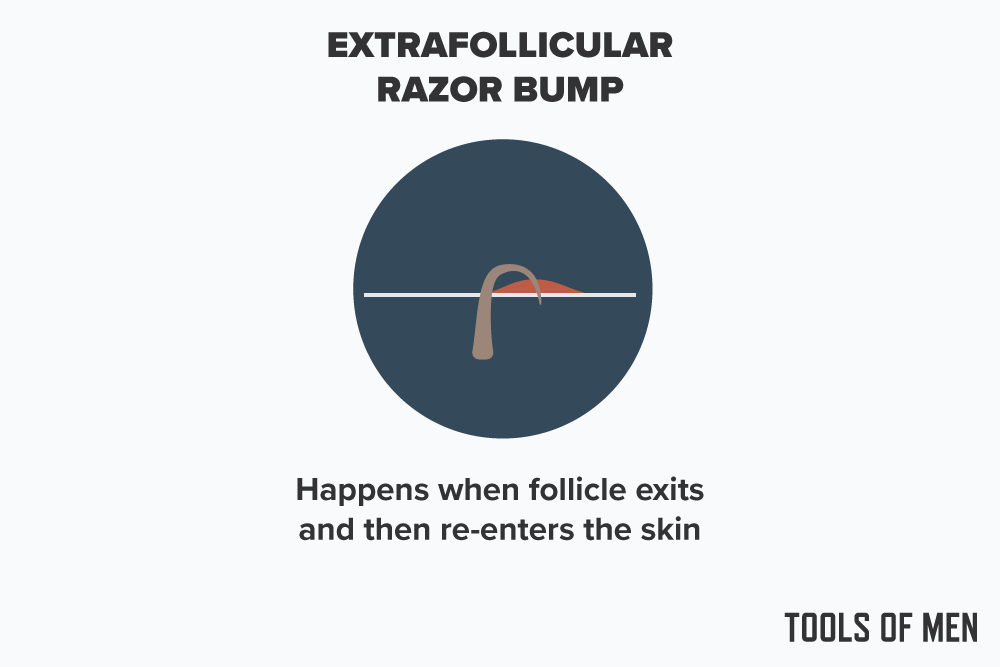
Transfollicular on the other hand is where a hair stays under the surface of skin the entire time and causes a bump to occur (also known as an ingrown hair):
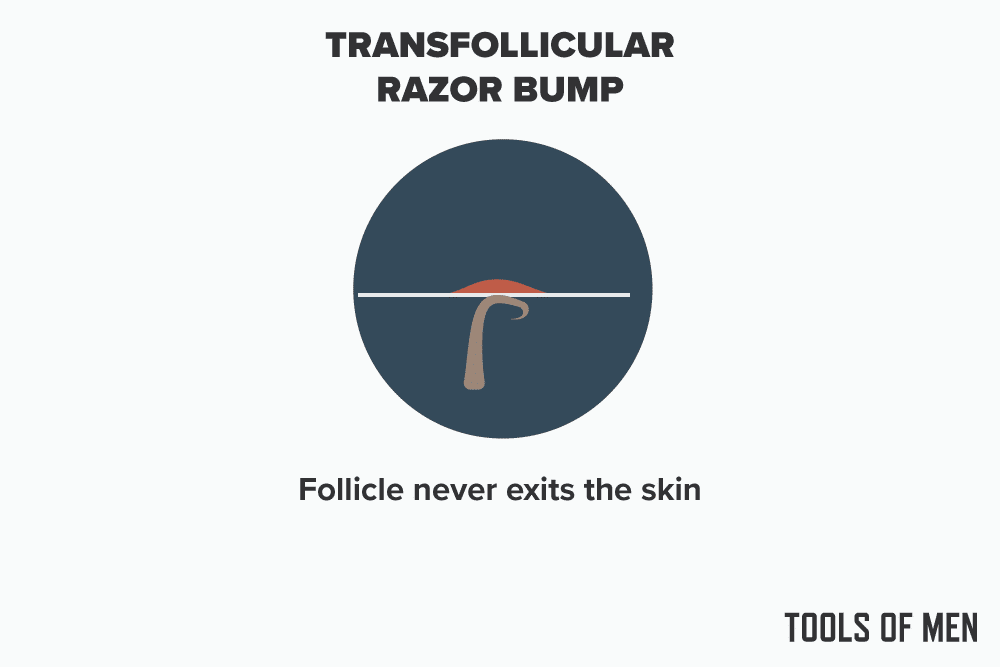
Now I know this sounds a bit dull…
…but this is really important!
Taking a minute to understand this will make for a near perfect chance of your razor bumps being cured once and for all…
…it worked for me.
So, how do these extra/trans follicular hairs happen in the first place?
For a few reasons:
First, genetics.
Razor bumps can occur anywhere on your body.
However, they are most prevalent on your neck or face as this is the area where you shave regularly.
Now, for some men, your hair may be really curly.
This naturally curly hair heightens the chance that it won’t properly leave the surface of your skin where was shaved down…
…or, if it did exit the skin properly, a curly hair may grow right back into the surface (a extrafollicular razor bump).
Now if genetics aren’t a factor – the second reason could be the razor blade.
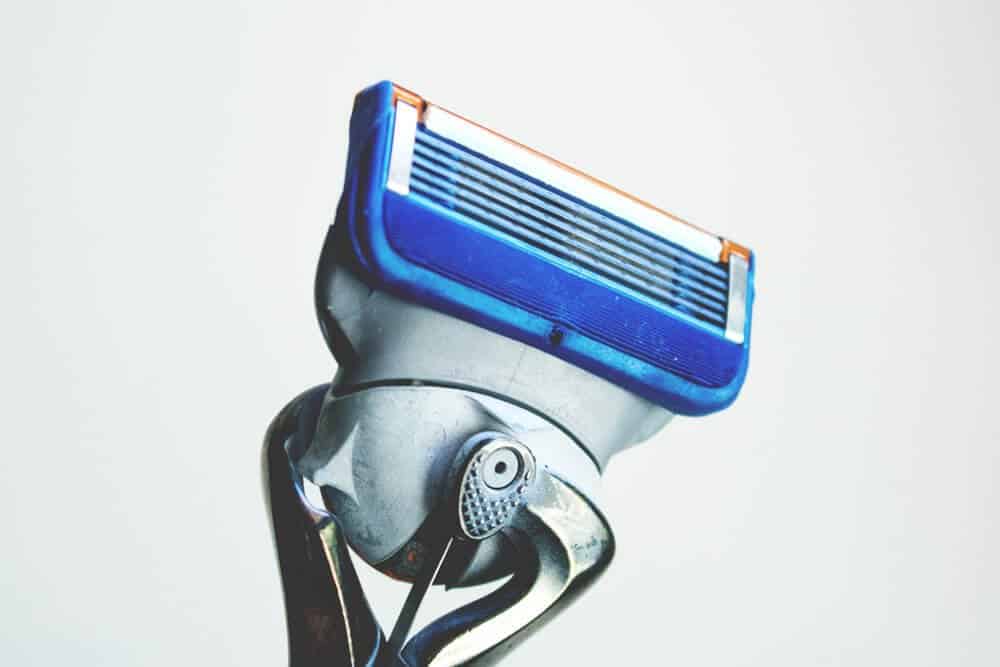
Of all the razor systems available, cartridge razors are the most popular (and also one of the leading culprits for causing razor bumps).
These multi-blade razors are incredibly effective at getting a close shave.
But when looking at them in tandem with razor bumps is where the troubles really begin to occur.
Here’s why:
Cartridge razors employ a lift-and-cut technique.
This means that the razor blades on the cartridge head work in tandem with one another to both simultaneously lift the hair follicle from the surface of the skin while the secondary razor blade cuts it down.
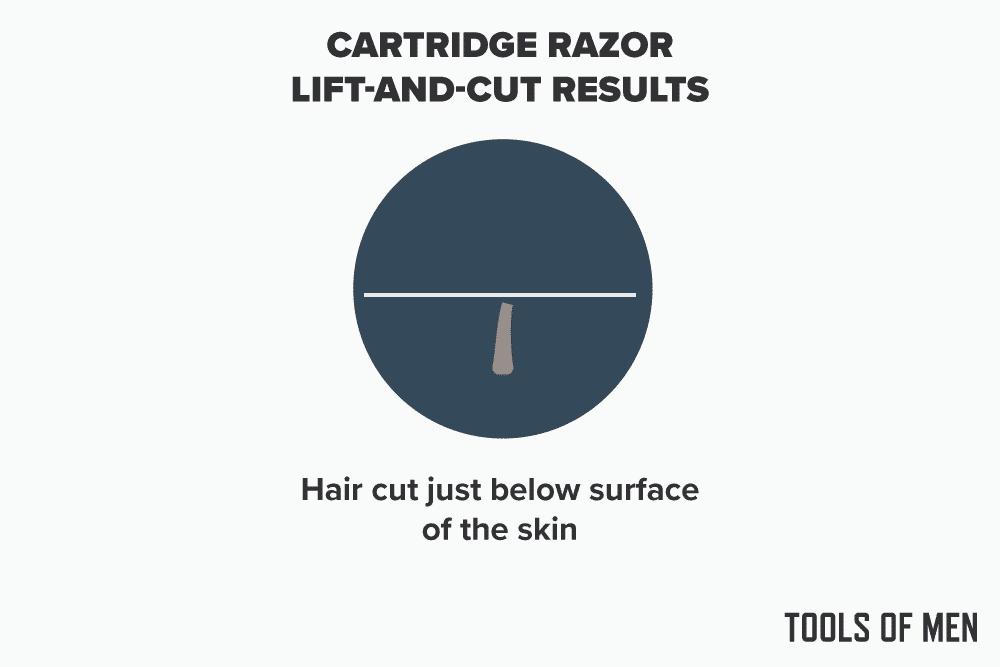
When the cartridge razor cuts down the hair too low, it gives the hair a larger chance of growing back into the skin and ultimately causes a razor bump.
Now, you will see why the freshness of the blade can be a huge reason for a razor bump in just a minute.
The third common issue causing a razor bump will be the direction in which you are shaving.
Not shaving properly by going across against the grain is the primary reason for razor bumps occurring.
You must make sure that you always shave with the grain.
This will help to prevent the hair from being cut too low and growing either transfollicular or extrafollicular.
Can You Really Cure A Razor Bump At All?
Now we want to talk about curing existing razor bumps (don’t worry we will cover my secret method next).
When it comes to dealing with existing razor bumps, you must be careful.
One of the common traps that I always found myself doing was trying to either pluck the hair completely out or shave over the area again (I figured at the time it would pop the hair free and allow it to grow straight out – big mistake).
Not only are a few of those methods extremely painful…
…but they just simply don’t work.
Oh, and regarding the regular application of tea tree oil – this can be quite irritating to some men’s skin as well, so it’s best to be avoided as a first course of action.
So, to reduce (note that I didn’t say remove) a razor bump, you have two primary methods:
- Anti-inflammatory
- Unfurl the hair
Common anti-inflammatories that have worked well for men may include ingredients like hydrocortisone (but must be used in moderation) or aloe vera (same ingredient to reduce pain from sunburns).
Razor bump solutions like Tend Skin and Bump Stopper are both often recommended by men as well.
However, if you follow the advice below to prevent future razor bumps, then you won’t need to use a product like these.
Now depending on the type of razor bump that you have can dictate whether you can use a tweezer at all.
If there is part of the hair that is sticking out of the bump (extrafollicular), you can use a pair of tweezers to get the end of the hair free from the skin and let it continue to grow in the proper outward direction…
…but if your razor bump is transfollicular (a hair that is completely under the skin) then it’s best not to further aggravate it with tweezers.
Doing so may result in infection should your tweezers contain any harmful bacteria on them.
Now some folks do recommend boiling tweezers to disinfect and then using them to dig out the hair, but this is not only ill-advised as it may lead to scarring of your skin tissue, but will also be incredibly painful.
Lastly:
And this one is important – under no circumstance should you shave over existing razor bumps.
It will not only make the issue worse, but it will likely lead to an infection as well.
My Fool-Proof Guide To Never Getting A Razor Bump Ever Again
Ok, time to get drop a knowledge-bomb guys:
Here’s my secret routine that has not only served me incredibly well – but actually works.
Oh, and you won’t need to purchase expensive depilatory creams, fancy razors, or even artisanal shave cream…
…none of that stuff matters.
Here’s the tried and true method to stop a razor bump ever occurring again:
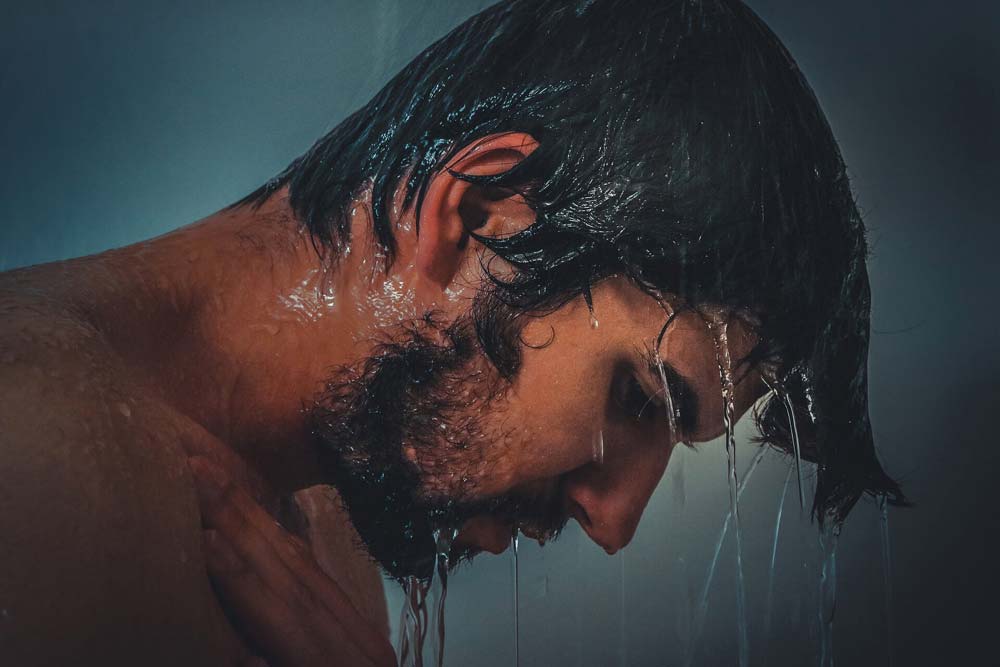
So first up, showering.
While it might not seem like a big deal from the onset, showering does a lot for your skin, hair, and warding off potential razor bumps.
Get this:
A warmer shower will be key in swelling the hair follicles that are to be shaved.
It makes it dead easy for the razor blade to make the cut.
Here’s why:
When you shower, the hairs will not only get thicker, but they will get a whole lot softer as well.
At the end of the day, it means this:
A softer hair means a cleaner cut.
And a cleaner cut means that it won’t be as easy for the hair to curl back into the skin.
And I know what you are probably thinking…
…I do this every time!!
…and if you do, great…
So was I…
…and I still got razor bumps!
But it all changed once I started doing these next couple of things:
First:
After the shower, you need to exfoliate (this shouldn’t be done more than a few times a week).
Now I know this may seem a bit too feminine to some…
But get this:
A chemical exfoliation relying on an AHA or BHA base, will not only further wash out any of the oily residue left on your face prior to showering, but it will also be effective at clearing out dead skin cells and soap scum.
Trust me when I say this:
Exfoliation is wholly underrated in prevent razor bumps.
But exfoliation is only part of the story…
Second:
One of the big things that I often see a lot of men have trouble with is being honest with themselves.
It’s not that they are ever really wrong, its more that they think their shaving process is acceptable enough in order to get by…
…and this where I found myself screwing up big time.
I like to think of myself as being a bit more frugal than most and will cut corners where possible.
Maybe it was my upbringing or perhaps it’s the sticker shock of plunking down $20 for a few cartridge razor blades – whatever the case may be, the simple fact remains:
I was not great at switching out my razor blades regularly.
To help force me out of this mindset I had to come up with a solution…
…I found that safety razor blades are WAY cheaper that cartridge blades – here’s the research I put together comparing both shave systems.
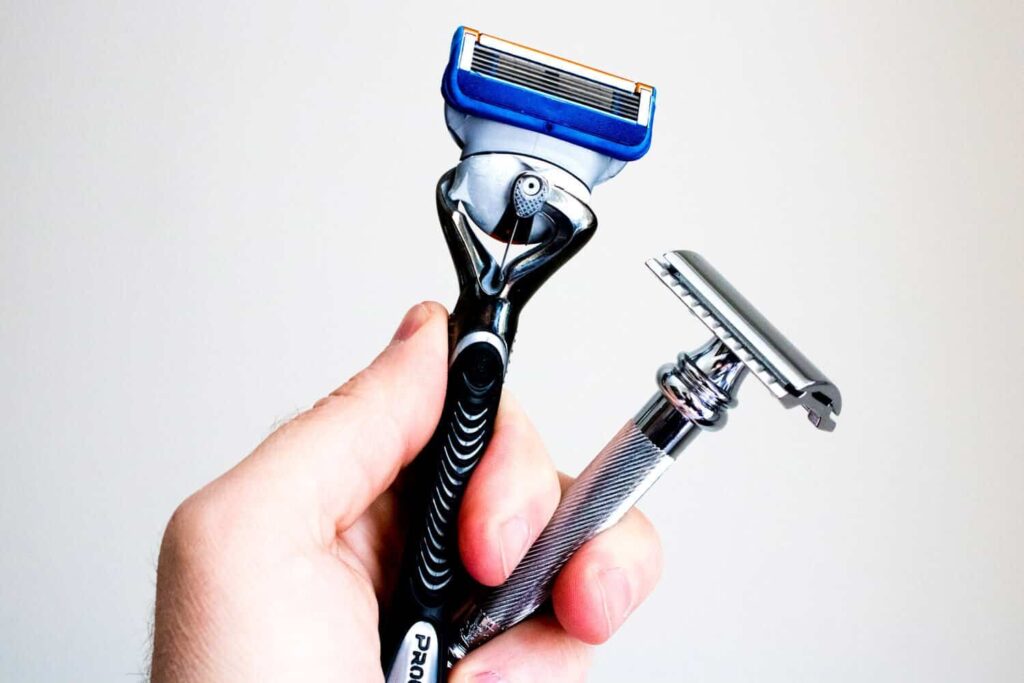
But if safety razors aren’t your thing, that’s ok…
…here’s another great option that works equally as well:
Subscription shave clubs are an affordable way to force new blades into your medicine cabinet weekly.
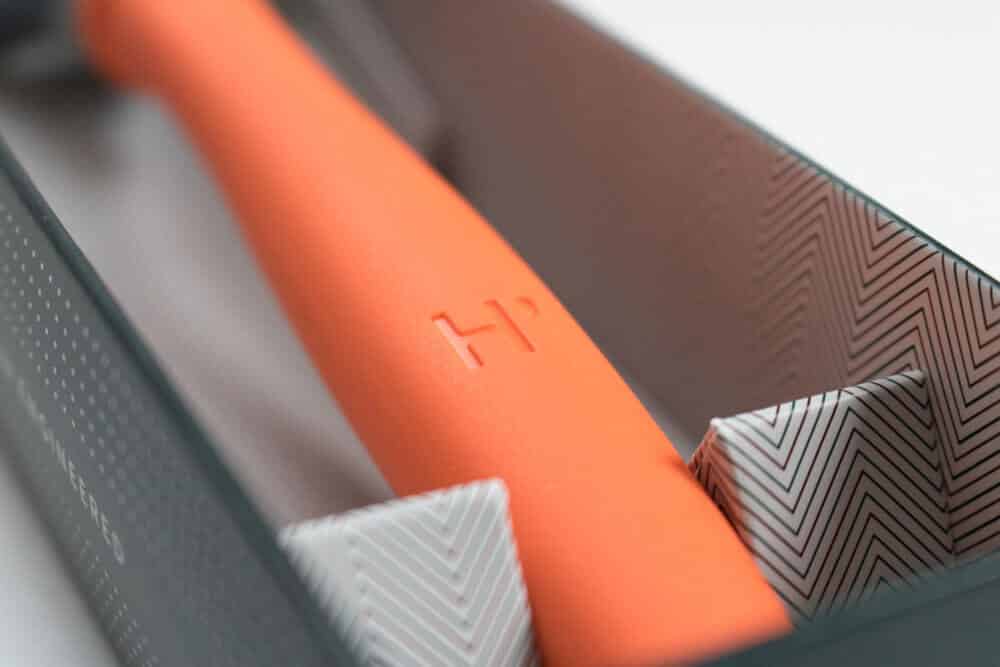
But here’s the kicker:
Fresh blades alone won’t make for razor bump free skin.
Technique is equally (if not more) important.
When it comes to shaving, you can’t do a hatchet job on your skin…
…you need to know how to identify hair growth patterns.
When it comes to razor bumps, you must shave with the grain.
Now I don’t care if you are using a cartridge, safety, or even the best straight razor, but when making the pass – it must go with the direction of the hair growth.
For men with naturally curly hair, this might be tricky…
…but you need to take two solid minutes before you shave and look at your hair growth.
Write it down or memorize it.
See how the hair comes in.
Make your razor go in the same direction.
So, if your neck hair grows upwards, shave upwards.
Or if it grows from left-to-right or right-to-left go in that same direction…
But it gets even more precise than that…
Look at your index finger:
Your razor blade should never travel further than the length of your index finger.
Short, yet precise strokes are key to shaving properly.
Now for the guys that want the much-desired baby butt smooth shave by pressing firm with the razor or going across or against the grain…
Forget about it.
It cuts the hair too short and will inevitably open you up to razor bumps.
But I know what you are probably thinking:
He totally forgot about the shave cream.
Yes, shave cream is important.
It’s great for making your skin supple and to provide a comfortable shave.
But when it comes to preventing razor bumps, it’s not the end all be all…
…based on my personal experience, shave cream helped but I didn’t need to go overboard.
A decent shave cream will be enough to insulate your skin to keep the hair swollen and provide decent results.
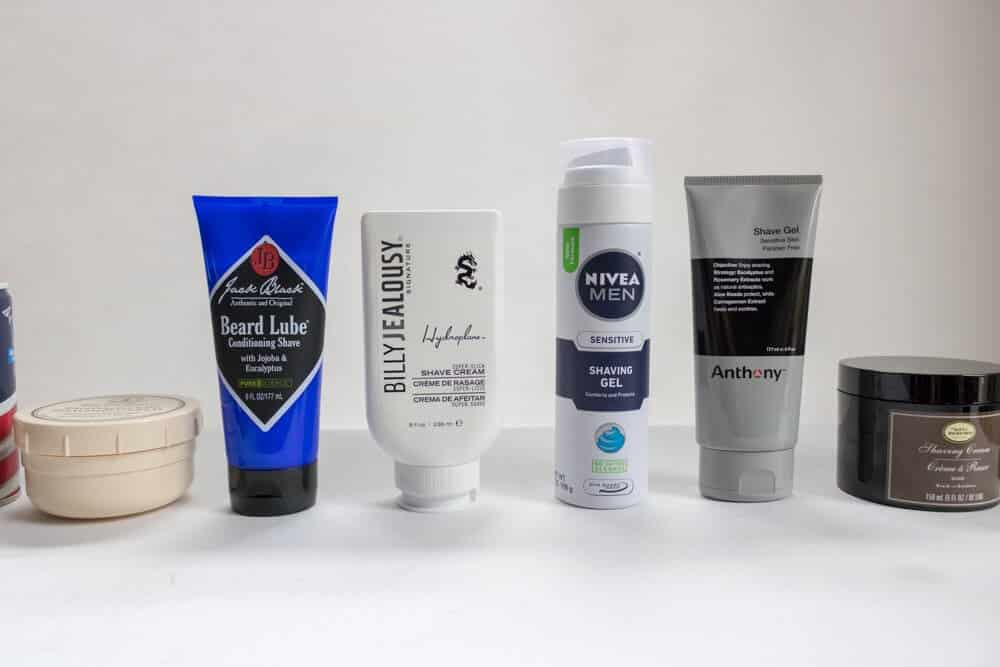
Now that’s it for the shave process…
…and you might think that’s where everything ends…
…but I fell into this trap as well…
Check this out:
Your skin is a living organ…
…in fact it’s the largest organ of our body (source).
When you shave, it does one heck of a stress test on the surface and your skin needs a bit of help to bring it back up to par.
The following helped to ward off future razor bumps:
First:
Don’t shave daily.
Especially if you have a job that doesn’t require you to shave.
Shaving daily not only keeps your hair always at the lowest possible level, but it just causes general irritation for a lot of men.
So, if you can, shave only a few times a week.
Second:
Moisturize.
I know incorporating an extra product into the whole morning routine can seem like another hassle for a lot of men…
But you got to trust me on this:
When dealing with razor bumps, dry skin makes it easier for the hair to penetrate the surface again and cause a razor bump.
When you shave, you are doing a number on the moisture barrier of the skin.
Simply applying a moisturizer after you are done shaving will not only keep your skin looking great but will help protect it from further damage.
Lastly, fabric:
Now I know everything in this guide talked about shaving on your face.
But the cold hard fact remains:
You can get a razor bump anywhere.
So, if you are shaving your groin, chest, face, or anywhere else – don’t wear skin tight clothes (think form fitting undershirts, active wear clothing, etc.).
This will increase the chance that the hair doesn’t have enough room to grow outwards and will be forced back into the skin…
…not good.
I Want To Help!
So guys, if you are lost and feeling like you have tried everything to no avail, drop a line below.
I want to try and see if we can work through it together and get your razor bumps completely gone forever.